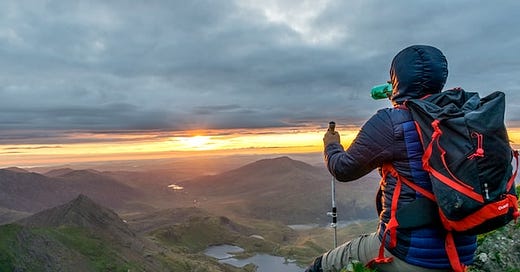Summer Weather Review
We're aware of the sizzling-summer stories, but what about the cold weather records that continue to topple around the world?
‘‘Greenland experienced A RECORD-BREAKING 7 GIGATON ICE GAIN - THE LARGEST EVER summer daily gain on record’’
DISCLAIMER: An imbalance in weather reporting has, in my opinion, reinforced the impression that we are accelerating towards a cow-fart and coal-induced climate catastrophe. So, as with all of my seasonal weather reviews, I intentionally focus on weather events that register at the bottom of the bulb.
I have included more than 30 teeth-chattering examples of record-breaking cold weather reports from around the world between June and August 2022.
Perhaps see if you can pick out your home location, or alternatively skip to the end to find out why (in my humble opinion), while some were sizzling in glorious hot weather, many others were experiencing bone-crunching, harvest-destroying cold and snow conditions.
Pour yourself a nice (warm!) cup of tea.. and if you find it interesting, please don’t forget to hit the share and subscribe and buttons, and of course you can follow me on Twitter for more insights and Atlas Report updates.
June
Brisbane, Australia; experienced its’ coldest seasonal temperature since 1904
Melbourne, Australia; had its’ coldest start to the month of June since 1982
Japan; multiple lowest-maximum temperatures ever-recorded were experienced across the country in June
Nueva Asuncion, Paraguay; set a national record-low for first half of June (-5.1 Celsius)
Lima, Peru; set it’s coldest temperatures in decades (13.1 Celsius).
New Brunswick and Maine, Canada; experienced their lowest daytime highs ever for the time of year
Caribou, USA; set an all-time June cold record (9.4 Celsius)
Pittsburgh, USA; had a record daily low (7.8 Celsius) equaling the previous benchmark set back in 1879
Dunedin, New Zealand; set a record June low (-8.6 Celsius), which was also just a whisker (0.2 Celsius) off the city's all-time coldest temperature ever recorded (since 1972)
Argentina; the National Meteorological Service confirmed that June was Argentina’s coldest June in twenty years!
July
The Gold Coast Seaway, Australia; Set it's coldest day ever recorded (14 Celsius)
Brisbane, Australia; experienced its’ coldest daily high in 22 years (12.4 Celsius)
Kununurra, Australia; this tropical town had its’ coldest low since 1965, (6 Celsius)
Kosanica, Montenegro; had its’ coldest July reading ever recorded (-2.2 Celsius)
Karajukića Bunari, Serbia; had its’ coldest July reading ever recorded (-1.4 Celsius)
Innisfail, Australia; had its coldest night on record (4.7 Celsius)
Alice Springs, Australia; had twelve consecutive days below zero - the longest ever streak of below-zero days
Sennybridge, Wales, UK; logged the nation’s coldest late-July temperature in decades (2.9 Celsius) just days after the country was effectively put on HIGH ALERT for record ‘heatwaves’
King Salmon, Alaska, USA; one of many Alaskan locations to break low temperature records for the month of July (1.7 Celsius).
Scandinavia; Sweden, Norway and Iceland all finished July with average temperatures some 0.3-0.5 Celsius below the mutli-decadal average
Australia; The country as a whole ended up with an average July temperature some -0.8 Celsius below the 1991-2020 average
Bermuda; July finished with an average temperature of 27.2 Celsius, -0.2 Celsius below the 1971-2000 baseline

August
Latacunga, Ecuador; a new record low for the month of August (-3.8 Celsius) and less than a degree from the national monthly low
Sao Joaqim, Brazil; had its’ lowest ever ground-temperature during the month of August (-13 Celsius)
Telfer, Australia; one of many Western Australian locations that saw record-low high temperatures tumble (between 9 Celsius and 12 Celsius)
Beijing, China; monthly low temperature records were broken in the province of Beijing, as well as Tianjin and Hebei provinces
Greenland; experienced a record-breaking 7 Gigaton ice gain - the largest ever daily gain during the summer (from records dating back to the 1980's)
Bratislava, Slovakia; experienced it’s lowest August daily high since 2010
Antarctica; the Antarctic Plateau plunged to -80.3 Celsius at the Italian-French station of Concordia continuing an 18-month cooling trend across the continent (see Twitter thread below for more details)

Midland International Airport, Texas, USA; experienced it’s lowest high temperature of just 26.1 Celsius, comfortably beating the previous record that had stood since 1965 (27.2 Celsius)
Faleolo International Airport, Samoa; had low temperatures (16 Celsius) that hadn’t been felt for 33 years, with a similar situation in Pago Pago on the neighboring American Samoan island.
‘The Sun is Dead’
While Rome, Italy had its’s ‘hottest ever day’, the highlands of nearby Spain and Portugal experienced frosts.
While the UK and France in Western Europe basked in unusually hot weather Eastern Europe felt chills more characteristic of winter-time.
Why such extremes?
Is it because of carbon dioxide, the sun, or both?
I’m going for the sun:
Simultaneous weather extremes are symptomatic of weak jet streams. The streams become ‘wavy’, and can meander far from their usual paths dragging warm, tropical weather systems towards the poles, and vice versa. So which extreme you get depends on which side of the wavy jet flow you happen to fall. The weak jet stream is attributed to the current weak solar cycle.

The heatwaves that characterized western Europe this summer were due to North African-heated weather systems being dragged uncharacteristically north. The chills in Eastern Europe from polar air masses dragged unusually far south.
I’ll finish with a quote my favorite maverick engineer of all things electromagnetic:
‘‘I pick it up on my radio equipment.. Right now the sun has gone dead. There is no more solar cycle which is going to have profound implications… people will be begging for Global Warming. It’s gonna get really cold. And humans are just gonna turn into animals…’’ Eric Dollard on THC, Oct 2019
I hope you enjoyed!
-Tristan






